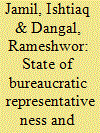|
|
|
Sort Order |
|
|
|
Items / Page
|
|
|
|
|
|
|
| Srl | Item |
| 1 |
ID:
088486


|
|
|
|
|
| Publication |
2009.
|
| Summary/Abstract |
The article compares the demographic composition of the Nepalese bureaucracy with the demographics of the general population, and, thereafter, maps the administrative culture in Nepal. With regard to administrative culture, it highlights, more specifically, the values and norms dominant among Nepali bureaucrats. In this regard, three relationships are focused upon: relationships among bureaucrats within the bureaucracy, the interface between the bureaucracy and politics, and the relationship between bureaucrats and citizens. Findings revealed that, in terms of demography, the bureaucracy in Nepal is gender biased, religion biased and caste biased, which means that the bureaucracy favors Hindu males who belong to the upper caste and come from an agricultural background. Therefore elitism, coupled with a rural background, has implications for the kinds of values and norms that evolve among Nepalese bureaucrats. From observations of its decision-making procedures and interpersonal relationships, both within and outside the bureaucracy, one may conclude that administrative culture is guided more by particularism than universalism, by ascription than achievement, by rule-orientation than result orientation, and by more authoritarian than participatory values. Most often, administrative decisions are taken on the basis of informal connections and close affinities than by formal and impersonal rules. Civil servants are often guided more by status orientation, ascription, hierarchy, and collective norms. These values are mere reflections of dominant societal culture based on caste and strict social stratification.
|
|
|
|
|
|
|
|
|
|
|
|
|
|
|
|
|
|
|
|
|